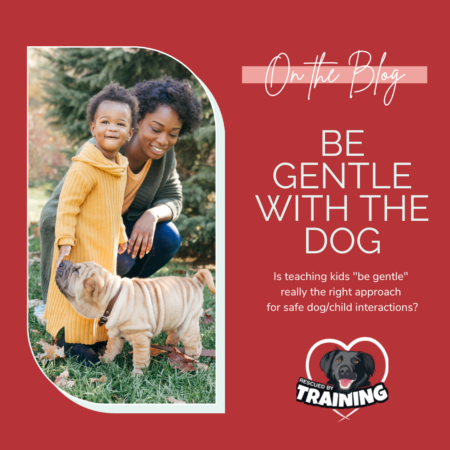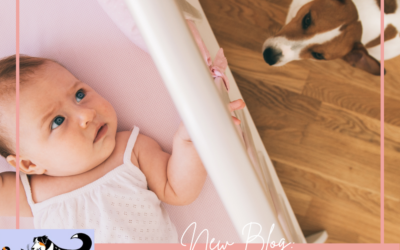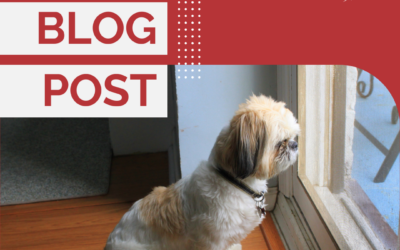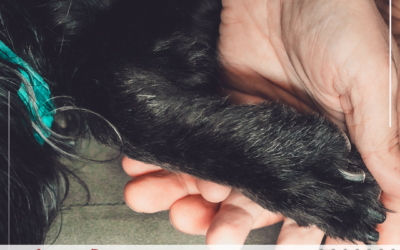Often in dog/toddler or dog/baby interactions I see parents urging their child to “be gentle” and while I’m sure this is well intentioned by the parent, it’s really not a safe way to allow your child to interact with your dog. Depending on the age of the child, it’s pretty likely the child may not fully understand what “be gentle” means or they are just not physically mature enough to implement that request. The cerebellum and cortex parts of the brain, the parts responsible for impulse control and motor function are not fully developed until much later on in life. So instructing a toddler to “be gentle” when they’re touching, squeezing, petting a dog just isn’t a skill that toddler is capable of executing. This isn’t a fault of the child – they’re just not developed enough yet.
And the risk of a mistake – the child grabbing too roughly, the child accidentally scaring or hurting the dog, or the dog pulling away from the child while they’re being grasped – could result in severe injury or at least a scary being snapped at incident for the child. Many dogs are afraid of young kids because they move erratically and touch dogs too roughly. Remember, dogs don’t understand intent. Your child may just want to love your dog, but if your child is hugging, kissing, staring at or grabbing your dog, your dog likely finds this scary or threatening. And if you think your dog is “kissing” your child as a sign of affection, be sure to read this post.
As a licensed Family Paws Parent Educator, Family Dog consultant and a certified behavior consultant and trainer whose speciality is fear and aggression, I work with a lot of families with dogs and kids. Part of the Family Paws program teaches, “invites decrease bites,” meaning an adult should be inviting interactions between the dog and child, not the child initiating it by wandering over to the dog. When dogs and kids cannot be supervised by a fully awake, adult, there should be separation by a physical barrier, like a baby gate or crate to prevent unintentional interactions.
The safer, more appropriate way of having your dog and child interact, especially when the child is young and not in full control of their motor skills or impulses, is to do parent-guided touch. This means we are taking the child’s hand under ours, with our fingers woven in the child’s fingers and the adult is guiding the child’s hand patting the dog. This ensures the child can’t grab the fur and also ensures the child doesn’t roughly pat too hard. We also want to model patting only with one hand, not two where the dog might feel trapped. “One hand enough, two hands too rough!” is another saying we use in Family Paws. As kids age, we can teach them age–appropriate supervised games and interactions and teach them ways to respect the dog, their body, their stuff and their space.
Dog-child safety isn’t 100% on the dog. We cannot expect dogs to just tolerate what we throw at them. Children should be taught from an early age that the dog is living creature with feelings and not a toy. Even the most gentle dog that tolerates a lot, will eventually reach a breaking point and if warning signs are not heeded this will likely result in a dog bite to the child. In fact, 77% of all dog bites are from family or familiar dogs and children are the highest statistical group. Don’t become a statistic.
Instead of saying “Be Gentle” teach these important things instead:
- Pet only neck to butt – not on top of the dog’s head and only with one hand.
- Do not approach the dog if they are eating.
- Do not approach the dog if they have a toy.
- Do not approach the dog if they are chewing on something.
- No kissing or hugging the dog. Here’s a good replacement for kissing a dog.
- No pulling any part of the dog – tail, ears or fur/skin.
- No sitting on, laying on or riding the dog.
- Do not put your face in the dog’s face.
- Do not pick up the dog.
- Do not touch or step on the dog’s paws.
- Do not poke the dog in the nose or eyes.
- Do not hit, kick or throw things at the dog.
- Do not yell at the dog.
Focus on safe, age-appropriate games where you and child are both engaged with the dog. Ask the child to help you do some caregiving tasks, like measuring out food, kibble fetch, watering, finding (but not picking up!) poop, carrying poop bags on walks (instead of letting them walk the dog) and other safe ways for the child to help.
Experience tells me, it’s always better to be proactive than reactive. If you’re expecting, now is the time to schedule a one on one pre-baby prep session to help prepare your dog (and you!) for the big changes ahead once the baby arrives and make your dog safer to be around. If your dog is already afraid of kids or strangers, you can set up a one on one fear and aggression consult to learn how to help them.
Happy training!
![]()




